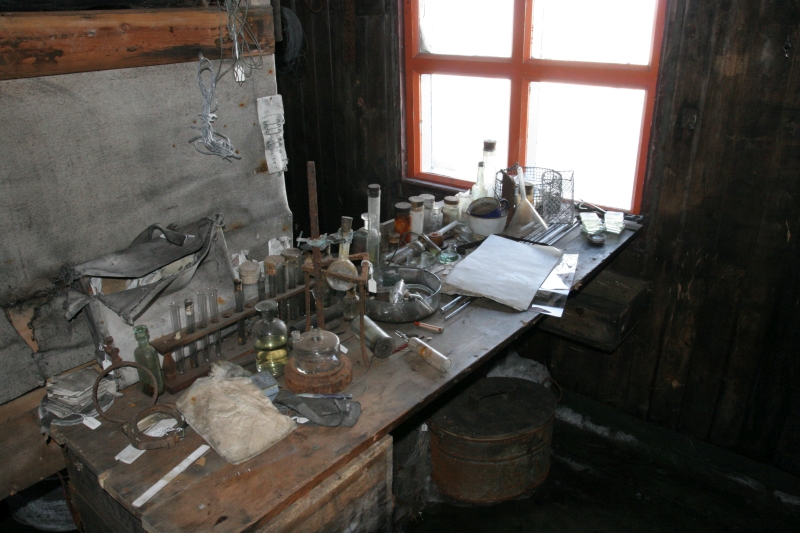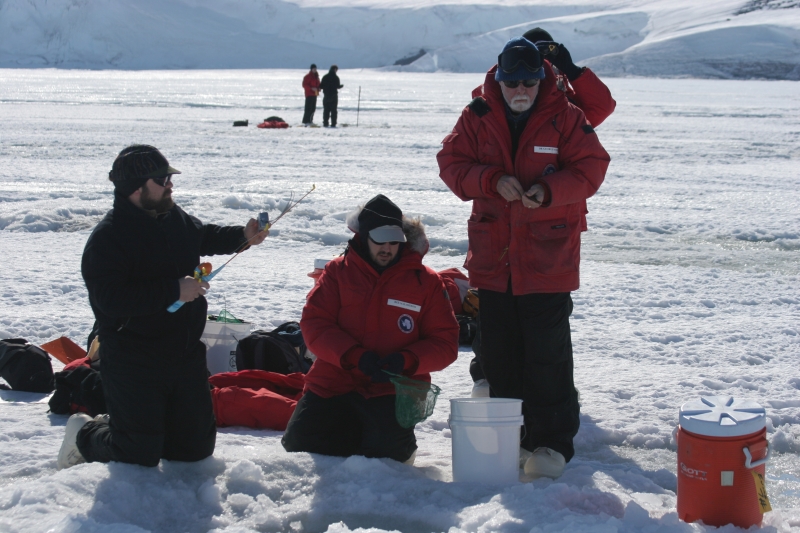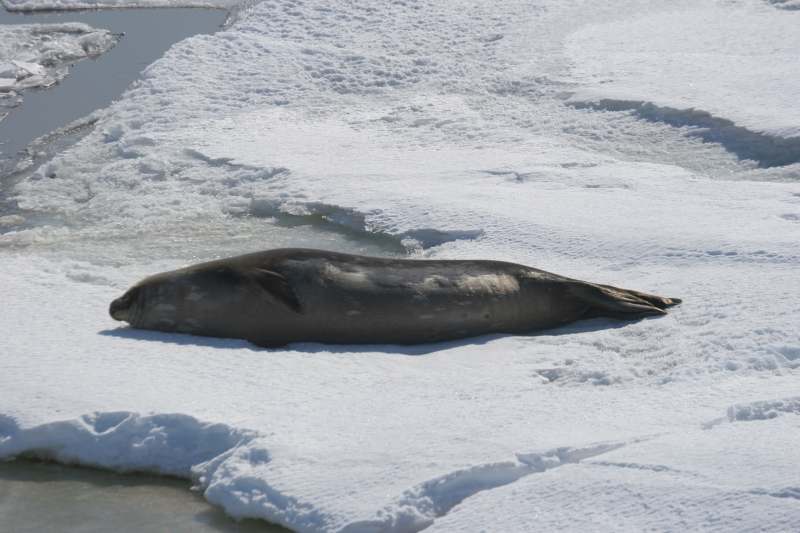1-20-06 Cape Evans
Last Friday we took a class trip out to Cape Evans, which is a
point ofland just a few miles north of McMurdo Station. This is
the site of Scott's nicer hut, where he based the operations of
his second attempton the South pole. The Cape Evans hut is a
substantially nicer hut for living in, as it is insulated and
larger than the hut at McMurdo.
Scott's hut sits surrounded by snow next to the water on Cape Evans. In the background is the Barne Glacier, which is moving down off the slopes of Mount Erebus until it meets the sea.

Outside Scott's hut is the anchor used to secure the ship Aurora to shore. The Aurora was part of Shackleton's last voyage to Antarctica. During a heavy storm in 1915 the anchor chain broke and the Aurora was blown out to sea, carrying much of the expedition's food and equipment with it.

Inside the hut you find fairly good living conditions. There are windows to let the light in, there was a phone setup to communicate with other huts on the island, and there were even covered stables for the ponies used on the South Pole expedition. The officers of the ship got to eat dinner at this fine dining table.

During Scott's 1910-1913 South Pole Expedition there were a number of scientists brought along to carry out experiments and observations during the time in Antarctica. The scientists were provided with facilities to do their work, and much of the gear was left behind. Here we see the biologist's lab bench, covered in science-y stuff.

Although I keep saying that this hut was comparatively luxurious by Antarctic standards, it's not exactly paradise. These are the beds inthe officer's quarters. Now, either everyone on the expeditions was a midget, or else they all had to sleep with their legs hanging off the end of the beds. You might imagine that the enlisted mens' sleeping arrangements were somewhat less plush than this.

The class trip also involved some sampling and collecting of organisms for use back in the lab at McMurdo. We took a walk around the pond system, which was somewhat reminiscent of the ponds at Bratina island. There were heavy growth of microbes and plankton in some of the ponds. We also went out onto the sea ice and punched our way through some old fishing holes in order to catch some more fish for the thermal tolerance experiments.
Those of you with sharp eyes will recognize the Square Bob SpongePants fishing reel on the left:

The fish were biting like crazy all afternoon long. It's not exactly a major fight to pull these fish to the surface, as you can tell by their size.

Some members of the group really got in to the fishing. We learned that they do things a little differently up in Canada, but the fishing technique, demonstrated here, seems to work equally well.

Lastly, the cracks in the sea ice around Cape Evans were home to a number of Weddell seals. The seals haul out on the sea ice near the cracks and spend the day sunning themselves before venturing back into the cold water to hunt for fish.

Scott's hut sits surrounded by snow next to the water on Cape Evans. In the background is the Barne Glacier, which is moving down off the slopes of Mount Erebus until it meets the sea.

Outside Scott's hut is the anchor used to secure the ship Aurora to shore. The Aurora was part of Shackleton's last voyage to Antarctica. During a heavy storm in 1915 the anchor chain broke and the Aurora was blown out to sea, carrying much of the expedition's food and equipment with it.

Inside the hut you find fairly good living conditions. There are windows to let the light in, there was a phone setup to communicate with other huts on the island, and there were even covered stables for the ponies used on the South Pole expedition. The officers of the ship got to eat dinner at this fine dining table.

During Scott's 1910-1913 South Pole Expedition there were a number of scientists brought along to carry out experiments and observations during the time in Antarctica. The scientists were provided with facilities to do their work, and much of the gear was left behind. Here we see the biologist's lab bench, covered in science-y stuff.

Although I keep saying that this hut was comparatively luxurious by Antarctic standards, it's not exactly paradise. These are the beds inthe officer's quarters. Now, either everyone on the expeditions was a midget, or else they all had to sleep with their legs hanging off the end of the beds. You might imagine that the enlisted mens' sleeping arrangements were somewhat less plush than this.

The class trip also involved some sampling and collecting of organisms for use back in the lab at McMurdo. We took a walk around the pond system, which was somewhat reminiscent of the ponds at Bratina island. There were heavy growth of microbes and plankton in some of the ponds. We also went out onto the sea ice and punched our way through some old fishing holes in order to catch some more fish for the thermal tolerance experiments.
Those of you with sharp eyes will recognize the Square Bob SpongePants fishing reel on the left:

The fish were biting like crazy all afternoon long. It's not exactly a major fight to pull these fish to the surface, as you can tell by their size.

Some members of the group really got in to the fishing. We learned that they do things a little differently up in Canada, but the fishing technique, demonstrated here, seems to work equally well.

Lastly, the cracks in the sea ice around Cape Evans were home to a number of Weddell seals. The seals haul out on the sea ice near the cracks and spend the day sunning themselves before venturing back into the cold water to hunt for fish.


<< Home